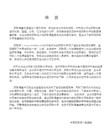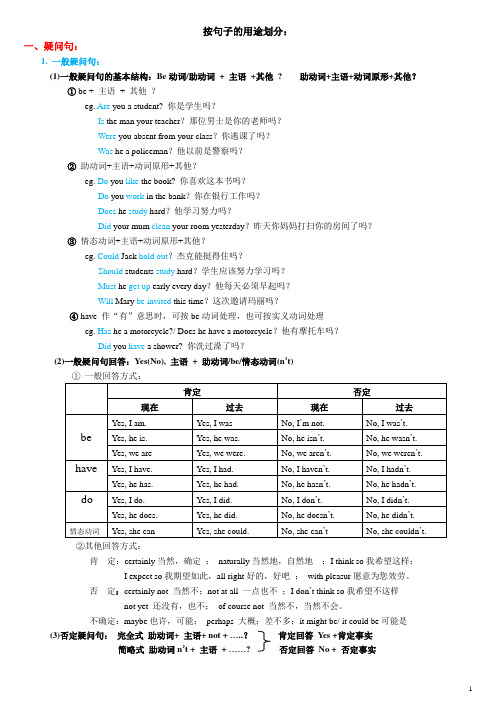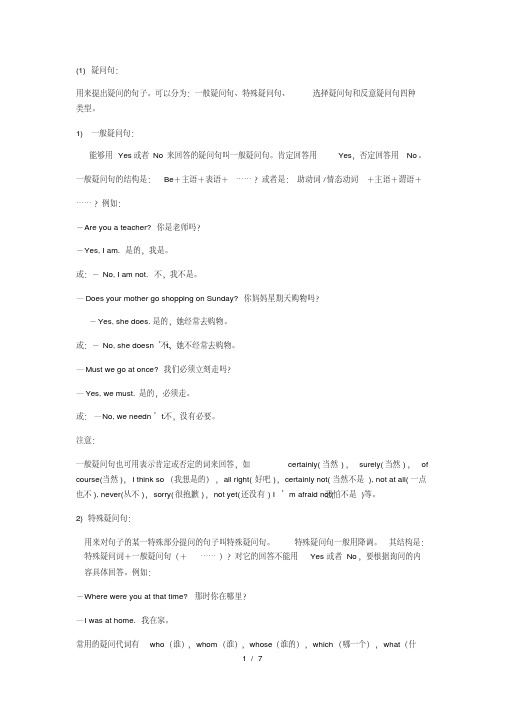初级中学英语语法疑问句和感叹句
【中考英语】初中英语知识点总结:陈述句、疑问句、感叹句和祈使句

另一种是:特殊疑问句+被选择部分(A)+or+被选择部
B)?也是在语调上有所区别。例如:Which vase shall
4、反意疑问句又叫附加疑问句,是指当提问的人对前
述句,后一部分是
解析:本题考查反意疑问句的构成。当陈述部分是I think
和D;主句部分don't表明是否定句,所以后面应用肯定
答案:A
误区提醒
对于反意疑问句的回答,一定要根据事实来回答,尤其
典型例题:——You've never seen dinosaur eggs, have
——_________. How I wish to visit the Dinosaur World.
2)Let + 宾语 + not + 动词原形 + 其它成分。如:Let
别让他走。
3)有些可用no开头,用来表示禁止性的祈使句。如:
!禁止吸烟!
常见考法
对于感叹句和祈使句的考查,常会出现在单选和完成句
典型例题:You should not talk in class.(改写同义句)
解析:题中strange clothes是形容词直接加名词构成的
what,clothes是不可数名词,不能加a.
答案:B
(他在香港几乎没有朋友。)
(c)代词:nothing, nobody, none等。I found nobody
(在那栋房子里我没看到任何人。)
二、疑问句
疑问句的主要交际功能是提出问题,询问情况。分为一
1、一般疑问句通常用来询问一件事情是否属实。答句
初中英语语法思维导图总结 - 句法之疑问句,感叹句,祈使句和陈述句

按句子的用途划分:一、疑问句:1. 一般疑问句:(1)一般疑问句的基本结构:Be动词/助动词+ 主语+其他? 助动词+主语+动词原形+其他?①be + 主语+ 其他?eg. Are you a student? 你是学生吗?Is the man your teacher?那位男士是你的老师吗?Were you absent from your class?你逃课了吗?Was he a policeman?他以前是警察吗?②助动词+主语+动词原形+其他?eg. Do you like the book? 你喜欢这本书吗?Do you work in the bank?你在银行工作吗?Does he study hard?他学习努力吗?Did your mum clean your room yesterday?昨天你妈妈打扫你的房间了吗?③情态动词+主语+动词原形+其他?eg. Could Jack hold out?杰克能挺得住吗?Should students study hard?学生应该努力学习吗?Must he get up early every day?他每天必须早起吗?Will Mary be invited this time?这次邀请玛丽吗?④have 作“有”意思时,可按be动词处理,也可按实义动词处理eg. Has he a motorcycle?/ Does he have a motorcycle?他有摩托车吗?Did you have a shower? 你洗过澡了吗?(2)一般疑问句回答:Yes(No), 主语+ 助动词/be/情态动词(n’t)②其他回答方式:肯定:certainly当然,确定;naturally当然地,自然地;I think so我希望这样;I expect so我期望如此,all right好的,好吧;with pleasur愿意为您效劳。
否定:certainly not 当然不;not at all 一点也不;I don’t think so我希望不这样not yet 还没有,也不;of course not 当然不,当然不会。
初中英语语法系列___祈使句感叹句

A. What B. What a C. How D. How a
句型4:What + 形容词 + 不可数名词 + 主语 + 谓语! 如:
------“
bad weather!”
------“ Yes, but it’s going to be fine soon, I think.”
A. How B. What a C. What an D. What
祈使句中需要注意的一些情况
1、有时为了表示委婉语气,可在句首或句尾加上please,但 please加在句尾时,前面要用逗号隔开。
Please sit down. / Stand up, please. 2、在意思较为明显的情况下可一把谓语动词省去。 This way, please. 3、有时为了明确的向对方提出请求或发出命令,可加呼语,
例题bright girls // they are!中竖线前的girls是名词(且不是 单数),尽管前面有形容词bright也不用how。
此外,如果运用“逆推法”找不到该句谓语动词,说明该句主 语和谓语都被省略,这时只要判断该句最后单词的词性即可 按上述方法进行判定。
-----“
bad weather!”
请先比较下面三组例句: (1)Come early, and you’ll catch the first bus. (好的结果)
初中英语语法归纳陈述句、疑问句、祈使句和感叹句

—___C___ . I like pop music.
A. Both
B. None
C. Neither D. Either
概念
结构
例句
—Must I finish the report today?
用yes, no来回 答的疑 问句为 一般疑 问句。
情态动词+主 语+ 动词原形
+ 其他?
助动词+主语 +动词原形/现 在、过去分词 +其他?
我今天必须完成这份报告吗? —Yes, you must. 是的,你必须完成。 —No, you needn’t./you don’t have to. 不, 你不必完成。
(2020·云南)
23. —___A_____was the car invented?
— It was invented in 1885.
A. When
B. Which
C. Who
D. Where
(2020湖北宜昌)
30. —_B_____ did the rules about keeping civilized dogs(文明
Do you want to go to the movies with me? 你想和我一起去看电影吗? Have you been to Tibet你去过西藏吗?
(2020甘肃白银) 句型转换。按括号内的要求转换下列句型。 (每空限填一词)
2. The Brows were watching TV when they got the phone call last night.(改为一般疑问句) _W__e_r_e____the Browns _w__a_t_ch__in_g_ TV when they got the phone call last night?
初中英语语法疑问句和感叹句

第15 讲_疑问句和感叹句知识图谱-疑问句-感叹句一般疑问句和特殊疑问句选择疑问句和反义疑问句What 引导的感叹句How 引导的感叹句第15 讲_疑问句和感叹句错题回顾疑问句知识精讲疑问句指提出问题,请对方回答的句子。
疑问句句末要用问号。
按结构可分为四一般疑问句、特殊疑问句、选择疑问句、反意疑问一、一般疑问句1、一般疑问句概述一般疑问句,也可称为是否型问句,因为它一般用yes 或no 回答的,基本的结构为:be/ 助动词/ 情态动词+ 主语+谓语/表语+(其他),句子要读升调。
对一般疑问句作肯定回答时,通常是Yes, 主语+be/ 助动词/情态动词;否定回答时,通常是No, 主语+be/ 助动词/ 情态动词+not ,not 通常用省略形式,如:---Can you swim to the other side ?你能游到对岸吗?---Yes, I can. 是的,我能。
---No, I can 't. 不,我不能。
注意:回答一般疑问句除了用yes 或no 外,也可用certainly ,probably ,perhaps ,of course ,all right ,with pleasure 等代替yes ,用never ,not at all 等代替no ,使得语气更加客气,委婉,如:---Can you help me? 你能帮个忙吗?---Certainly. 当然。
---Could you please make less noise? 你可以小声一点吗?---All right, sir. 好的,先生。
---Have you been there? 你到过那里吗?---Never. 从来没有。
二、特殊疑问句1. 特殊疑问句概述特殊疑问句多以who ,where ,when ,which ,whose ,why 这类词开头,其结构一般为:特殊疑问词+ 一般疑问句,即:特殊疑问词+be/ 助动词/ 情态动词+ 主语+ 谓语/表语+(其他),通常读降调,如:Who is it on the phone? 谁来的电话?How many oranges can you see in the picture?你能在图画上看到多少个橘子?2. 疑问副词三、选择疑问句选择疑问句一般提出两种或两种以上的可能,问对方选择哪一种。
初中疑问句、祈使句、感叹句

(1)疑问句:用来提出疑问的句子。
可以分为:一般疑问句、特殊疑问句、选择疑问句和反意疑问句四种类型。
1)一般疑问句:能够用Yes或者No来回答的疑问句叫一般疑问句。
肯定回答用Yes,否定回答用No。
一般疑问句的结构是:Be+主语+表语+……?或者是:助动词/情态动词+主语+谓语+……?例如:-Are you a teacher? 你是老师吗?-Yes, I am. 是的,我是。
或:-No, I am not. 不,我不是。
—Does your mother go shopping on Sunday? 你妈妈星期天购物吗?-Yes, she does. 是的,她经常去购物。
或:-No, she doesn’t.不,她不经常去购物。
—Must we go at once? 我们必须立刻走吗?—Yes, we must. 是的,必须走。
或:—No, we needn’t. 不,没有必要。
注意:一般疑问句也可用表示肯定或否定的词来回答,如certainly(当然),surely(当然),of course(当然),I think so(我想是的),all right(好吧),certainly not(当然不是), not at all(一点也不), never(从不),sorry(很抱歉),not yet(还没有) I’m afraid not(恐怕不是)等。
2) 特殊疑问句:用来对句子的某一特殊部分提问的句子叫特殊疑问句。
特殊疑问句一般用降调。
其结构是:特殊疑问词+一般疑问句(+……)?对它的回答不能用Yes或者No,要根据询问的内容具体回答。
例如:-Where were you at that time? 那时你在哪里?—I was at home. 我在家。
常用的疑问代词有who(谁),whom(谁),whose(谁的),which(哪一个),what(什么);疑问副词有when(何时),where(何地),why(为什么),how(如何)以及“how+形容词”构成的短语。
初中疑问句、祈使句、感叹句

(1)疑问句:用来提出疑问的句子。
可以分为:一般疑问句、特殊疑问句、选择疑问句和反意疑问句四种类型。
1)一般疑问句:能够用Yes或者No来回答的疑问句叫一般疑问句。
肯定回答用Yes,否定回答用No。
一般疑问句的结构是:Be+主语+表语+……?或者是:助动词/情态动词+主语+谓语+……?例如:-Are you a teacher? 你是老师吗?-Yes, I am. 是的,我是。
或:-No, I am not. 不,我不是。
—Does your mother go shopping on Sunday? 你妈妈星期天购物吗?-Yes, she does. 是的,她经常去购物。
不,她不经常去购物。
或:-No, she doesn’t.—Must we go at once? 我们必须立刻走吗?—Yes, we must. 是的,必须走。
或:—No, we needn’t. 不,没有必要。
注意:一般疑问句也可用表示肯定或否定的词来回答,如certainly(当然),surely(当然),of course(当然),I think so(我想是的),all right(好吧),certainly not(当然不是), not at all(一点也不), never(从不),sorry(很抱歉),not yet(还没有) I’m afraid not(恐怕不是)等。
2) 特殊疑问句:用来对句子的某一特殊部分提问的句子叫特殊疑问句。
特殊疑问句一般用降调。
其结构是:特殊疑问词+一般疑问句(+……)?对它的回答不能用Yes或者No,要根据询问的内容具体回答。
例如:-Where were you at that time? 那时你在哪里?—I was at home. 我在家。
常用的疑问代词有who(谁),whom(谁),whose(谁的),which(哪一个),what(什么);疑问副词有when(何时),where(何地),why(为什么),how(如何)以及“how+形容词”构成的短语。
初中英语语法大全-句子种类

初中英语语法大全-句子的种类按照英语句子的使用目的和用途,句子可分为四类:陈述句(Declarative Sentence)、疑问句(Interrogative Sentence)、祈使句(Imperative Sentence)和感叹句(Exclamatory Sentence)。
陈述句包括肯定陈述句和否定陈述句。
疑问句有一般疑问句、特殊疑问句、选择疑问句和反意疑问句。
图解语法1. 陈述句说明一个事实或陈述一个人的看法,陈述句包括肯定陈述句和否定陈述句特别提示:肯定陈述句改成否定句或一般疑问句时,如句中有already,some,something,somebody等词,须分别改成yet,any,anything,anybody等。
另外,也要注意,too改成either,both改成neither,all改成none等。
2. 疑问句3. 常用的特殊疑问句4. 特殊的反意疑问句①主句是祈使句时,“will you?”意为“请求”,“won’t you?”表示提醒对方注意。
例句:Look at the blackboard, will you / won’t you?Don’t be late again, will you?②感叹句后的反意疑问,用一般现在时态的否定形式例句:What fine weather, isn’t it?How beautifully she sings, doesn’t she?③陈述部分是“I am …”时,用“aren’t I?”而不用“am not I?”例句:I'm working now, aren’t I?④陈述部分主语是everything,nothing,anything或something 时,疑问句主语用it例句:Something is wrong with my radio, isn’t it?Nothing is difficult, is it?⑤陈述部分的主语是somebody, nobody, everybody, anybody, no one,none, neither 时,疑问句的主语用they例句:Everyone is here, aren’t they?No one knows about it, do they?⑥陈述部分的主语是:1) this或that时,问句的主语用it2) these或those时,问句主语用they3) there be句时,反意疑问句中用there例句:This is a plane, isn’t it?These are grapes, aren’t they?There was a hospital here, wasn’t there?⑦陈述部分的主语是one时,问句的主语可用one,也可用you (美语用he)例句:One should be ready to help others, shouldn’t one?⑧陈述句中有few, seldom, never hardly,not,rarely,no,nobody,too…to等时,疑问句部分用肯定结构;如由前后缀构成否定词,疑问句部分仍用否定结构例句:He is never late for school, is he?You got nothing from him, did you?It is useless, isn’t it?⑨陈述部分主语是从句、不定式(短语)、动词-ing形式时,疑问句的主语用it例句:What you need is more important, isn’t it?⑩陈述部分由think, believe, suppose, imagine等引导的宾语从句:1) 主语是第一人称时,问句与从句的主谓语一致2) 主语是其他人称,问句与主句的主谓语一致例句:I think he will come, won’t he?I don’t think he can pass the exam, can he?He believed you had seen her before, didn’t he?? have是实义动词时,疑问句用助动词do,does,did;have 是助动词,则不然例如:They had a meeting just now, didn’t they?She’s been to many places of interest, hasn’t she?? 陈述部分有have /has /had to 时,疑问句要用助动词的否定形式例句:You have to water the vegetables now, don’t you?? 陈述部分有had better时,疑问句中用hadn’t刘局:We had better go to school at once, hadn’t we?? 陈述部分有must:1) 作“一定;必须”解释时,疑问句用mustn’t或needn’t;2) 表示推测,作“一定是;必定”解释时,疑问句需根据其后的动词原形选用相应的形式;3) 对过去动作推测时,问句的助动词用did或have;4) 对过去的状态推测时,问句的be用was例句:He must work hard at physics, mustn’t he?You must go to Guangzhou, needn’t you?You mustn’t smoke here, must you?Tom must be at home, isn’t he?She must have finished her work, hasn’t/didn’t she?He must have been a policeman, wasn’t he?? 陈述部分有ought to,used to,疑问句要用 shouldn’t,usedn’t / didn’t例句:Jill used to be a teacher, usedn’t / didn’t she?? 陈述句部分是复合句时,疑问句的主语和助动词要与主句一致例句:He was reading when the teacher came in, wasn’t he?特别提示:反意疑问句是“否定陈述句+肯定问句”时,如回答内容是肯定的,用“Yes+肯定结构”,反之,用“No+否定结构”。
- 1、下载文档前请自行甄别文档内容的完整性,平台不提供额外的编辑、内容补充、找答案等附加服务。
- 2、"仅部分预览"的文档,不可在线预览部分如存在完整性等问题,可反馈申请退款(可完整预览的文档不适用该条件!)。
- 3、如文档侵犯您的权益,请联系客服反馈,我们会尽快为您处理(人工客服工作时间:9:00-18:30)。
知识图谱-疑问句-感叹句一般疑问句和特殊疑问句选择疑问句和反义疑问句What引导的感叹句How引导的感叹句第15讲_疑问句和感叹句错题回顾疑问句知识精讲疑问句指提出问题,请对方回答的句子。
疑问句句末要用问号。
按结构可分为四种:一般疑问句、特殊疑问句、选择疑问句、反意疑问句。
一、一般疑问句1、一般疑问句概述一般疑问句,也可称为是否型问句,因为它一般用yes或no回答的,基本的结构为:be/助动词/情态动词+主语+谓语/表语+(其他),句子要读升调。
对一般疑问句作肯定回答时,通常是Yes, 主语+be/助动词/情态动词;否定回答时,通常是No, 主语+be/助动词/情态动词+not,not通常用省略形式,如:---Can you swim to the other side?你能游到对岸吗?---Yes, I can. 是的,我能。
---No, I can’t. 不,我不能。
注意:回答一般疑问句除了用yes或no外,也可用certainly,probably,perhaps,of course,all right,with pleasure等代替yes,用never,not at all等代替no,使得语气更加客气,委婉,如:---Can you help me? 你能帮个忙吗?---Certainly. 当然。
---Could you please make less noise? 你可以小声一点吗?---All right, sir. 好的,先生。
---Have you been there? 你到过那里吗?---Never. 从来没有。
二、特殊疑问句1. 特殊疑问句概述特殊疑问句多以who,where,when,which,whose,why这类词开头,其结构一般为:特殊疑问词+一般疑问句,即:特殊疑问词+be/助动词/情态动词+主语+谓语/表语+(其他),通常读降调,如:Who is it on the phone? 谁来的电话?How many oranges can you see in the picture?你能在图画上看到多少个橘子?2. 疑问副词三、选择疑问句选择疑问句一般提出两种或两种以上的可能,问对方选择哪一种。
其结构可用一般疑问句,也可用特殊疑问句,供选择的两部分由or连接,前者用升调,后者用降调。
选择疑问句也分为一般选择疑问句和特殊选择疑问句,但回答不能用yes或no回答,都要用完整的句子。
1. 一般选择疑问句一般选择疑问句的结构为:一般疑问句+A or B?如:---Will you go there by bus or by train?---I will go by train.—你准备乘汽车,还是乘火车去那儿?—我会坐火车去。
2. 特殊选择疑问句特殊选择疑问句的结构为:特殊疑问句,+A or B?如:---What would you like, coffee or tea?---I would like coffee.—你想要什么,咖啡还是茶?—我想来点咖啡。
四、反意疑问句1. 反意疑问句的构成反意疑问句是一种常用于口语的疑问句,这种问句由两部分组成,前一部分是陈述句,后一部分是附加的一简短问句,中间用逗号隔开,因此,反意疑问句又称附加疑问句。
如果陈述句是肯定句,附加问句用否定句;如果陈述句是否定,附加问句用肯定句,即“前肯后否,前否后肯”。
附加问句一般为“be动词(助动词、情态动词)+代词”构成,如:They didn’t clean the classroom yesterday, did they?他们昨天没有扫扫教室,是吗?You’re coming, aren’t you?你会来的,不是吗?2. 反意疑问句的答语1).反意疑问句的答语一般由yes或no引导的简略答语来回答,但是要注意时态及代词的呼应,如:---She is your teacher, isn’t she? 她是你的老师,是吧?---Yes, she is. 是的,她是。
---No, she isn’t. 不,她不是。
2). 在前否定后肯定的句子中,yes含义为“不”,no含义为“是”,如:She can’t swim, can she? 她不会游泳,对吗?Yes, she can. 不,她会。
No, she can’t. 是的,她不会。
三点剖析一、考点及延伸:中考考查疑问句重点如下:特殊疑问句中疑问词的辨别和选择;反意疑问句的提问和回答;否定形式反意疑问句的回答的正确理解。
除了语法的考查,疑问句也常在各种文章中出现,能够正确理解疑问句,能很大程度地帮我们正确理解语言环境。
以下两点是疑问句考点延伸:1. 否定的特殊疑问句一般有劝告,建议,责备等意味,如:Why don’t you finish your homework?=Why not finish your homework?为什么不完成作业呢?2. 陈述句谓语动词是wish,表示征求意见时,反意问句用may,如:I wish to have another piece of cake, may I?我想再要一块蛋糕,可以吗?I wish to go home now, may I?我想现在就回家,可以吗?二、方法总结疑问句是考试中的高频考点,重点考查疑问词选择和反意疑问句。
疑问词的选择一般考查与介词的结合,比如how far, how long等一系列,重点区分各自含义和回答;反意疑问句考查较简单,只要遵循“前肯后否,前否后肯”原则即可,注意hardly, seldom, never等有否定含义的词的出现,视为否定句,疑问部分用肯定形式。
题模精讲题模一一般疑问句和特殊疑问句例1.1、---Are you sure you can do well in the final exam?---_________, I’ve got everything ready.A、N o, I’m not sureB、I t’s hard to say.C、Y es, I think soD、I hope not例1.2、---_________ is your father?---A.bank clerk. He works in a bank near my home.A、W hereB、H owC、W hatD、W hich例1.3、对划线部分提问。
________________________________________题模二选择疑问句和反义疑问句例2.1、_____________________________________________例2.2、---Is this a Chinese book or an English book?---Oh, _________A、y es, it is.B、n o, it isn’t.C、a n English book.D、a music book.例2.3、Tom can hardly do it well, _________?A、c an heB、c an’t heC、d oes heD、d oesn’t he例2.4、---Don’t smoke in the reading room, _________?---I’m sorry. I won’t do it again.A、w ill youB、s hall weC、d o youD、c an you随堂练习随练1.1、---Excuse me, can I use your pen?---_________. Here you are.A、Yes, of course.B、No, you can’t.C、You are welcome.D、It doesn’t matter.随练1.2、She usually does some housework on Sundays. (改为一般疑问句) _____________________________________________随练1.3、_____________________________________________随练1.4、---_________ is your father? Does he still work as an engineer?---Yes, he has been an engineer for thirty years.A、WhoB、HowC、WhatD、Which随练1.5、---_________ is the World Cup held ?---Every 4 years.A、How soonB、How manyC、How oftenD、How long随练1.6、--- Did you use to have straight or curly hair, Cindy?---_________. I like that hair style.A、Yes, I didB、Straight hairC、No, I didn’tD、Not curly hair随练1.7、I don’t think the newly directed film by Zhao Wei is as interesting as people say, _________?A、do IB、don’t IC、is itD、isn’t it随练1.8、Jim needn’t sing this song. (改为反意疑问句)_____________________________________________随练1.9、You need to wait for her. (改为反意疑问句)_____________________________________________感叹句知识精讲感叹句一般是用来表示说话时的喜悦、惊讶等情感。
英语感叹句常用“what”和“how”引导,“what”和“how”与所修饰的词置于句首,其它部分用陈述句语序。
一、由“what”引导的感叹句“what”意为“多么”用作定语,修饰名词(被强调部分),单数可数名词前要加不定冠词a/ an,复数可数名词或不可数名词前不用冠词。
总结其句子结构可分为以下三种:1. 可用句型:“What + a/ an+形容词+可数名词单数+主语+谓语!”。
如:What a nice present it is! 它是一件多么好的礼物啊!What an interesting book it is! 它是一本多么有趣的书啊!2. 可用句型:“What+形容词+可数名词复数+主语+谓语!”。
